Two Worlds II Review
by Mark R
|
 It was a time of unrest, with distant mutterings being whispered from brother to brother, each word twisting and turning until none could remember what was truth and what was merely fabrication. While some spoke of a shadow on the horizon lumbering towards them at a slow yet unrelenting pace, rising from once forgotten ashes, others dismissed the tales out of hand as nothing more than rumour. Believers who stood on corners preaching of this second coming, forever ridiculed as each day passed without incident now stand tall as news of the beast’s approach is confirmed by sightings from all over.
It was a time of unrest, with distant mutterings being whispered from brother to brother, each word twisting and turning until none could remember what was truth and what was merely fabrication. While some spoke of a shadow on the horizon lumbering towards them at a slow yet unrelenting pace, rising from once forgotten ashes, others dismissed the tales out of hand as nothing more than rumour. Believers who stood on corners preaching of this second coming, forever ridiculed as each day passed without incident now stand tall as news of the beast’s approach is confirmed by sightings from all over.
The beast of which I speak is not some fabled mythical creature but rather Two Worlds II. Originally touted as an add-on called “The Temptation” back in November 2007 with a release date of the first half of 2008, but which never happened. As time went on, The Temptation became less likely and was ultimately shelved by Reality Pump in favour of a full sequel which, itself, became plagued by constant delays to the point where the UK will finally see Two Worlds II made available almost two years on from the original expected release date of March 27th, 2009. After more than three years of hype for those who waited for the sequel with bated breath, shying away from the hordes of naysayers who found no redeemable qualities in Reality Pump’s original release, will Two Worlds II have what it takes to live up to such sustained anticipation? Fans of the original certainly won’t be disappointed.
Whilst you step once again into the shoes worn in Two Worlds, your character has been out of commission for the past five years and, as such, has grown weak over this time so you are effectively starting over with no skills or abilities. Although this does seem a little odd, as I can’t imagine anyone would forget every skill they’d learned after a five year hiatus, it does mean that you get to immerse yourself in what is ultimately the life force of any good role playing game: character building and levelling. During the obligatory tutorial level, involving your breaking out of Castle Vahkmaar after being imprisoned by Gandohar, various cut scenes and quick time events tell of the Orcs siding with the humans in an attempt to overthrow Gandohar as he rules his empire by fear. It becomes clear very early on that the back bone of Two Worlds II is a much stronger storyline than that of its predecessor, being heavily rooted in politics and steeped in choices which will shape the way the story unfolds and although the theme of the previous game still exists where you are ultimately trying to free your sister from Gandohar’s clutches, the political subtext is actually a much stronger than that of your plight to reunite with your troubled sibling.
 By the time you grab your first mace to stave off Guardians that are hell bent on preventing you from leaving Castle Vahkmaar, for fear of being torn limb from limb by Gandohar and his Jedi mind tricks, it’s already clear that this is not going to be a rehash of the original game. This is obviously a good thing, but also has the potential for being quite a negative if there is too much change happening all at once. As someone who genuinely enjoyed Two Worlds, despite originally turning off the demo after thirty minutes and not going back to it for months, I was hoping that enough of the quirky charm of the original would be retained but everything that could be improved upon would be improved upon and it doesn’t take long for those hopes to be confirmed.
By the time you grab your first mace to stave off Guardians that are hell bent on preventing you from leaving Castle Vahkmaar, for fear of being torn limb from limb by Gandohar and his Jedi mind tricks, it’s already clear that this is not going to be a rehash of the original game. This is obviously a good thing, but also has the potential for being quite a negative if there is too much change happening all at once. As someone who genuinely enjoyed Two Worlds, despite originally turning off the demo after thirty minutes and not going back to it for months, I was hoping that enough of the quirky charm of the original would be retained but everything that could be improved upon would be improved upon and it doesn’t take long for those hopes to be confirmed.
The voice acting in Two Worlds was much maligned and, while I do admit that it was ropey at times and had some pretty dreadful dialogue in places, there was also a great deal of humour in the main character and his interactions with those that were met on his travels. Unfortunately, most people couldn’t see the humour for what it was and took the stance that it was just poorly written dialogue, such as the hero singing “It’s raining, it’s pouring” to himself whenever the skies turn dark with storms, regular one liners whenever beasts were slain and frequent blurts of “Forsooth” and “Thouest” as well as other ‘olde worlde’ phrases. To me, that was part of the charm of the original and I was overjoyed to hear “Gotta be brave to enter a cave” on entering my first underground location and “Gentlemen… and or monsters” as I ran up to take out a rhinoceros on the Savannah. While the hokey one liners are still there, the medieval dialogue has been kicked to the curb in favour of plain English and the voice acting of the main character is, in my opinion, superb. With a throaty timbre like a vibrator thrust into a bucket of granite chips, the lead character sounds very much like Christian Bale in his portrayal of Batman and I was convinced at one point that I was listening to Terence Stamp voicing another but have it on good authority that it wasn’t really him… but that shows the quality of the voice acting compared with the original. There are times, however, where they probably spent a little too much of the budget on take away pizza whilst burning the midnight oil and had to cut back on the voiceover budget for some characters but, overall, it’s a vast improvement and that trademark humour is still present.
 |
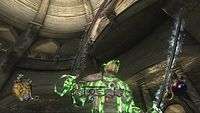 |
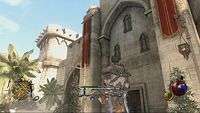 |
 |
 |
 |
There are areas within the game which are very self referential and not only poke fun at the whole role playing genre, but also at Two Worlds itself. Going in to too much detail would obviously spoil the gameplay for anyone who decides to embark on their own journey through Antaloor but there is one occasion where you happen upon a character in the “Under The Influence Inn” who immediately starts rabbling in the traditional Two Worlds speak of “forsooth”, “doth”, “thou”, “spaketh” and is met by derision by your character, asking if he needs his head examined. Other areas where the fourth wall is broken include retorts such as “Chance of death, little pay, no respect… I’ll do it” and “You could have told me this before I came from that very place to deliver this here” when being asked to return to pick something else up in the typical errand boy mode so often associated with the role playing genre. I am, of course, paraphrasing in these examples as I was too busy laughing to take verbatim notes and I’d rather you discovered them for yourself but my point is that if you’re wanting serious or depressing dialogue then you’re barking up the wrong enchanted tree. Other gems such as turning a corner in the middle of nowhere and finding someone urinating up against a tree, or bent over to vomit their entire stomach contents are the little touches that separate this from others.
There are, as far as I’m concerned, three huge features introduced to Two Worlds II in the shape of the CRAFT system, the ability to sail the oceans, and the Oculus. Tackling them in order, the CRAFT system (Complete Reshaping And Forging Technology) builds upon the previous method of stacking similar items to make much more powerful versions, but takes this to an entirely new level of customisation and control which begins with disassembling existing weapons and armour in to component parts. Holding the left bumper and pushing the ‘Y’ button on the XBox whilst selecting an item in the inventory screen will break that particular item down in to separate elements, so a shield may be composed of only two units of wood whereas a sword may provide iron and steel and a helmet is likely to produce iron, leather and even chainmail.
Whenever you have enough raw materials at your disposal, any applicable items will immediately display an animated hammer to let you know that this item can be upgraded with whatever elements you have available. Upgrading weapons and armour will also unlock slots for enchanting your items with crystals, and the number of crystals you can use depends on the level of the item you’re upgrading so to use three crystals on a sword you would have to upgrade twelve times. It’s also important to note that, as with the previous game, you can’t mix elemental damage on one weapon so if you’ve already placed a crystal with fire damage then it’s impossible to compliment that by adding frost, poison or shock damage so you’re limited to either swapping one damage type for another or adding further skill crystals such as strength, stamina, thrust or anything else that adjusts your attributes.
With the Antaloor map consisting mainly of water with various islands dotted around, it was only a matter of time before sailing was introduced to the Two Worlds universe. Purchasing a boat from the docks at New Ashos allows the player to explore the open seas in search of even more enemies to kill… and parrots. I found the sailing to be a very steep learning curve, starting off in a relatively small fenced off area where it was nigh on impossible to manoeuvre the boat and the sail into a position where the wind could actually catch the sail and allow me to turn the vessel around. After tinkering around for an age, passing the controller over to someone else and watching them struggle until finally the wind changed direction, we were finally tearing through the waves at a relatively high speed. From that point on, with plenty of open sea in which to manoeuvre, sailing became as intuitive as walking or riding a horse… but far more poetic and idyllic. If you’re not careful enough to alter the position of the sails on your approach to land, the speed at which you hit the shore can be such that you find your boat wedged on the bank and it’s difficult to get enough traction to push it back in to the water. For the most part though, you’ll either slow down enough to jump out and leave the boat in the water (it doesn’t drift off, thankfully) or you’ll run aground to the point where you can still easily push the boat out and sail off on yet another adventure.
 |
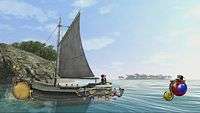 |
 |
 |
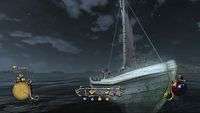 |
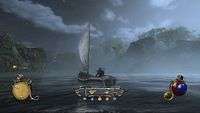 |
 |
 |
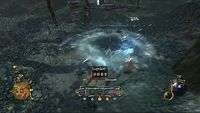 |
They say that the best defence is a good offense, and an Oculus will give you this in spades. Available from standard corpse and chest lootings, the Oculus is a disembodied eye that has been enchanted to allow the holder to control it as a means to scout the location without putting themselves in danger. Those with the highest speed and longest range will prove to be more useful in the long run as they can very easily give you a visual on the next three or four minutes of combat so you know in advance what you’re getting yourself in to, but there are other more powerful devices which come with an array of damage options from magical missiles to explosives that can effectively take down several enemies from the blast. The more powerful the Oculus, however, the shorter the range and the more obscure the view so it’s best to reserve these for those moments where there are three or four enemies around a corner and you don’t have the necessary weaponry to take them out. With the Oculus not being part of the previous game, it’s very easy to forget about them but once you get used to thinking ahead then you’ll find them invaluable and it makes for a fantastic addition to the gameplay.
The introduction of the GRACE engine by Reality Pump means that they have effectively built Two Worlds II from the ground up, starting from a blank canvas and writing their own game engine to be able to cope with everything that they wanted to achieve, such as the Oculus, and it shows. Gone are the badly ported inventory systems from Two Worlds, which had little or no effort put in to allow them to be easily managed on a console, and in their place are a series of easily legible and intuitive screens with a keen attention to detail at every turn.
 Levelling up is handled by splitting the various skills into six separate sections: Warrior, Ranger, Mage, Assassin, Crafting and General. Each of these sections has twelve individual skills which can be built upon by spending skill points earned through either moving to a new level or completing one of the in-game challenges such as picking a certain number of locks.
Levelling up is handled by splitting the various skills into six separate sections: Warrior, Ranger, Mage, Assassin, Crafting and General. Each of these sections has twelve individual skills which can be built upon by spending skill points earned through either moving to a new level or completing one of the in-game challenges such as picking a certain number of locks.
The skills themselves consist of a wheel made up of ten segments, allowing you to vary the emphasis from one skill to the next to take your character in a particular direction.
Attribute points are earned only through levelling up and can be spent on Endurance, Strength, Accuracy and Willpower depending on how you want to progress your character, so someone wanting to concentrate more on archery over spell casting would spend more points on Accuracy than Willpower. To further explore the possibilities of expansion, certain skills can’t be enhanced until one of the attributes has reached a certain level and no skill can be developed until a skill book has been read, which means completing quests to obtain such books or paying exorbitant prices to vendors… as much as 13,000 Auras (the unit of currency in Antaloor) depending on the vendor.
Buying and selling across Antaloor is a skill in itself in Two Worlds II as every vendor has their own price for every individual item, so while an Executioner blade may cost 9000 Auras from one vendor, it may cost as little as 6000 from another or as much as 12,000 from the trader across the street and the amount they’re willing to pay for items is reflected in their greed. Unlike the previous game, commerce in Two Worlds II is dictated by the laws of supply and demand. If a vendor buys a shield from you for 500 Auras then the next shield you try to sell will be worth considerably less because, naturally, they have less demand for the item as they now have it in stock. As you sell more of the same item, or item type, the amount offered to you by the vendor will reduce until the base price is reached. This leaves you with yet another choice: whether to sell one of each item type to one vendor and then move on to the next trader or save time and take a hit financially by selling everything you can to a single merchant. In the earlier stages of the game it’s wise to shop around and trade with as many vendors as possible but when you reach the point where you have more Auras than you realistically need, it’s simpler and quicker to sell to whichever merchant you’re currently dealing with. That said, I’ve found that perhaps eighty percent of the items I find or loot are being broken down to upgrade other items and I rarely hold on to anything long enough to sell.

Vendors in Antaloor can sell anything from pigments to skill books, daggers to damage crystals, depending on their location but just be sure to shop around as you could be paying double and selling for half in some stores.
For those of us who prefer to exercise our grey matter during gameplay, Two Worlds II offers a level of environmental interaction that’s not often found within the role playing genre and is generally reserved for games in the Tombraider mould: puzzle solving. Rather than providing nothing more than background decoration, barrels and crates within Antaloor have a degree of interactivity where they can be moved around, lifted and even thrown at attackers… but there’s more to them than that. Arranging crates by pushing them around or lifting one on top of the other means that you can effectively create stairs to get to hard to reach areas, or sift through a pile to find a hidden chest. I’m told there are also occasions where throwing a barrel at an out of reach lever will open up another route for the character, although I’ve yet to come across any such situation myself. Either way, the developers have created a world where you have the ability to wander off the beaten track in any direction at any time, and can use the environment to your benefit and that is what an open world game should be all about. Freedom.
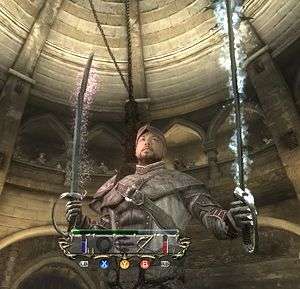 There is an incredibly steep difficulty curve in Two Worlds II and so the earlier stages of the game generally involve downing a considerable amount of potions after a fight or, in some cases, mid fight. With no option to sleep or wait, you are relying on potions and alchemy to regenerate health until such times as you have enough skill points to work on building up the health regeneration skill within the General skill set. Once you start to develop that particular skill, putting away any weapons immediately throws you in to a cool down mode where your character replenishes health until you again produce your weapon. As most RPG gamers are very exploratory by nature, it’s very easy to ignore quests in favour of discovering new locations and, in turn, new enemies… which can be great for accruing XP but detrimental to your health if you do as I did and start to fight Giant Scorpions with nothing more than a tinfoil Short Sword or end up trying to kill a level 25 Cyclops with a level 3 character.
There is an incredibly steep difficulty curve in Two Worlds II and so the earlier stages of the game generally involve downing a considerable amount of potions after a fight or, in some cases, mid fight. With no option to sleep or wait, you are relying on potions and alchemy to regenerate health until such times as you have enough skill points to work on building up the health regeneration skill within the General skill set. Once you start to develop that particular skill, putting away any weapons immediately throws you in to a cool down mode where your character replenishes health until you again produce your weapon. As most RPG gamers are very exploratory by nature, it’s very easy to ignore quests in favour of discovering new locations and, in turn, new enemies… which can be great for accruing XP but detrimental to your health if you do as I did and start to fight Giant Scorpions with nothing more than a tinfoil Short Sword or end up trying to kill a level 25 Cyclops with a level 3 character.
Another high degree of difficulty comes with the lock picking mode which, when faced with a Master Lock and not much in the way of lock picking skill, can mean going through an insane number of lock picks in a short space of time. There is an option to go with the “Auto Lockpick” which shows the success probability as a percentage before you make that choice, but it tends to be on the low side and so it’s best to at least attempt to pick the lock properly. Approaching a locked chest with your weapon drawn will provide you with the option to break the lock using your weapons, but can sometimes result in damaging your weapons if you fail an attempt when the damage probability is beyond the zero percent mark. While the game boasts the opportunity to pick pockets of unsuspecting NPCs, they have to be preoccupied with something else before you are even provided with the option to steal, yet I’ve never once been able to do this at any point other than when the skill is first introduced and you’re tasked of picking the pockets of three imbecilic guards. Part of me is glad that I’ve not been able to do it, as the process itself is mostly down to chance and you can’t use your skill unless there is a valid opening in the very short space of time afforded… but I’d also like to put my sneaking ability to better use, and so it’s quite disappointing that I’ve never come across anyone else stupid enough to not notice my character standing behind them with his hands in their pockets.
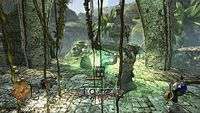 |
 |
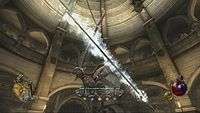 |
 |
 |
 |
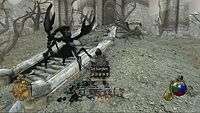 |
 |
 |
The d-pad in Two Worlds II takes on an entirely different role than you’d normally expect and, rather than assigning a different weapon or item to the various points of the d-pad, the up, left and right positions switch between “Weapon Sets” and the down position is used to draw and sheath weapons. There are obvious disadvantages to this method of game mechanics in that you’re first of all limited to only three different choices of item, and you can’t assign anything other than weapons or armour to each set, so the option of having all bases covered by perhaps a sharp quiver, blunt quiver, long ranged bow, short ranged bow, blunt weapons, swords and maybe even different enchanted weapons is no longer a possibility. What you get in exchange, however, is actually a pretty ingenious mechanism that can be used to immediately switch between entire armour, weapon and even jewellery sets… so if you’ve assigned the left position to being your archery set, you can have all your rings and amulets swap over to those which enhance your marksman abilities and have armour which increases accuracy. The same can be said for having a full weapon set geared specifically for close combat blunt weaponry, enhancing your strength and stamina and providing more protection without the worry of losing the much needed accuracy for the archery weapons. While this was very bewildering and disappointing at the start when I expected to be able to map eight weapons/items, it’s become an invaluable addition to the gameplay and I now wonder how I ever managed without it. Someone at Reality Pump needs a pay rise for that one.
The spell casting in Two Worlds II is something that I’ve actually ended up avoiding because it relies on having a staff rather than being able to cast regardless of whatever weaponry you’re currently using. The level of customisation within the Mage Skills section is quite incredible though, with every new card altering the outcome of the spell so you’re not limited to using whatever prebuilt spells were on offer in the first game, and are instead expected to toggle cards on and off to generate your own specific spell type. A quick flick of a save before spending an obscene amount of attribute and skills points allowed me to experiment with different spells and, although they were incredibly impressive, the thought of giving up one of only three weapon sets meant that I was having to either sacrifice my ranged weapon or blunt weapons in favour of a Mage staff… something that I couldn’t bring myself to do, and so I reloaded the save and went back to using regular weaponry. Had they gone with the stereotypical, and perhaps overused, method of casting using the hand rather than a staff then I would be championing the Mage skills more than I am currently, especially after watching others experiment with the Modifier cards to create all manner of custom spells.
 The physics in the game are best utilised in the Mage skills, with the power to generate physics objects in real time to create a tornado shield which levitates whatever free objects are around you and uses them to encircle the character as a means of protection. Felled enemies are also whipped up from the ground and pulled in to the tornado, along with their weapons, to add strength and power to an already impressive spell. The real time physics calculations involved for this type of manoeuvre, as well as the collision arising from your enemies being smacked in the face by another of their kin, is something which I’ve not seen in any console game to date so either this is something brought about by the GRACE engine or I just haven’t stumbled upon it elsewhere.
The physics in the game are best utilised in the Mage skills, with the power to generate physics objects in real time to create a tornado shield which levitates whatever free objects are around you and uses them to encircle the character as a means of protection. Felled enemies are also whipped up from the ground and pulled in to the tornado, along with their weapons, to add strength and power to an already impressive spell. The real time physics calculations involved for this type of manoeuvre, as well as the collision arising from your enemies being smacked in the face by another of their kin, is something which I’ve not seen in any console game to date so either this is something brought about by the GRACE engine or I just haven’t stumbled upon it elsewhere.
Graphically, the quality of the textures and characters are night and day when compared to Two Worlds but there is one major distraction for me which has taken me a considerable amount of time to become accustomed to, and that’s the enforced depth of field. In order to achieve a sense of realism, a lot of game designers are opting for an environment where foreground objects are in perfect focus and backgrounds are increasingly blurred depending on the distance from the camera’s point of view. While this does make for a more comfortable playing field, allowing enemies to be easily distinguishable from the surrounding environment, it does come at a price: shimmering edges. To differentiate between background and foreground, it would appear that the background is initially blurred and then the foreground objects are placed back in the environment as though they have a blurred version of themselves directly behind them, and this causes an odd shimmering effect. It’s not as noticeable in towns and cities, and certainly not in interior locations such as buildings or caves, but when out in the Savannah it’s very distracting to see trees shimmering even if you’re standing perfectly still. This problem may be limited to consoles and their limited graphic power, but I can’t help but think that a little antialiasing and some anisotropic filtering would have worked wonders and so I’m looking forward to playing through the game on the PC at a later date to take advantage of increased graphic power.
Having said that, every other visual aspect of the game is fantastic in terms of texture quality and I’ve found myself stopping to just take in the beautiful scenery or wander up to a door to admire the level of clarity in the wood work. Running through forests has foliage parting as you reach it and snapping back into position behind while enchanted weaponry illuminates the environment as you wade through the darkness towards enemies, the different colours of each enchantment reflecting on the walls and ground as you go. The amount of particle detail is quite staggering, with torches spitting fire as you run and casting very realistic shadows in real time along with dust particles swirling around behind you as you run through caves, dancing in the light being generated by the enchanted weaponry. While the character animations and lip synching don’t quite stand up to those of the almost five years old Oblivion, the level of detail in the landscapes and of the weaponry and armour leave Oblivion standing at the wayside with its Khajiit mouth hanging open in envy, and I find that baffling. Baffling that so much attention has been paid to the intricacies of the particles, weaponry, interiors, locations and beasts… yet the character animations which, let’s face it, are the vessels through which the story is told, are left wanting more often than not.
 |
 |
 |
 |
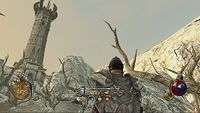 |
 |
When all is said and done though, even the most seasoned graphics whore such as myself will only mumble now and again when something in particular stands out but, for the most part, the story itself and the various side quests therein are strong enough to balance out such graphical niggles. As you can see from the screen shots taken directly from the game, when the graphics are working to the game’s advantage they really are working hard to impress and succeed more often than they fail.
 Fans of Gothic 3 may recognise Borislav “Glorian” Slavov as the composer of the Two Worlds II soundtrack, taking over from Harold Faltermeyer and Ambermoon to provide a less European sound and a score more suited to the various individual locations within Antaloor. As before, the player is provided with audible cues when the atmosphere becomes heavy as enemies near, before returning to a more tranquil and serene theme once our hero is left standing atop a mound of warm corpses. Although I was pleasantly surprised by the main theme of Two Worlds and the haunting melodies of Ambermoon, I had grown tired of it after a while and was glad to hear this fresh approach with the sequel and Slavov has done an outstanding job of capturing the essence of Antaloor.
Fans of Gothic 3 may recognise Borislav “Glorian” Slavov as the composer of the Two Worlds II soundtrack, taking over from Harold Faltermeyer and Ambermoon to provide a less European sound and a score more suited to the various individual locations within Antaloor. As before, the player is provided with audible cues when the atmosphere becomes heavy as enemies near, before returning to a more tranquil and serene theme once our hero is left standing atop a mound of warm corpses. Although I was pleasantly surprised by the main theme of Two Worlds and the haunting melodies of Ambermoon, I had grown tired of it after a while and was glad to hear this fresh approach with the sequel and Slavov has done an outstanding job of capturing the essence of Antaloor.
As well as the game’s score itself, music has been introduced as a means to earn money for those more discerning players who would rather avoid breaking in to homes and robbing people of their few possessions. Instruments can be bought from vendors and musicians, along with the sheet music necessary for playing through a song. The player has the option to go solo and busk in the streets or ask another fellow musician for accompaniment so you can let them do all the hard work while you stand there banging your bongos in time. The instrument mini games are genuinely difficult, and moreso than any Guitar Hero or Rock Band game, especially if you opt for the violin or harp. During the mini games, the bumpers and triggers are assigned their own track of notes just like any other “play along” game but each instrument has its own level of difficulty with the drums being the simplest and using only the left and right triggers (someone clearly never heard of Mike Portnoy) and the violin being the most difficult as you not only have to control the notes with the left bumper and trigger but the right side has you performing prolonged bowing with the trigger and bumper. The longer the accuracy streak, the more money you’ll earn from your performance. Considering the instruments and sheet music are ridiculously inexpensive to buy at only a few Auras each, this is a fantastic way to earn money in the early stages of the game but, as someone who is terrible at any Guitar Hero type game, I’ve stuck to drums and only earned around 1600 Auras per performance.
One aspect I’ve not managed to delve in to yet is multiplayer, and it does appear to offer a considerable number of options as well as a dedicated multiplayer campaign which means you’re not limited to playing through a tacked on bone being thrown at the co-op lover. Not only do you create a dedicated multiplayer character, but you deal with entirely different locations and quests that don’t exist in the single player campaign. One of the more intriguing aspects of the multiplayer options is the “Village Mode” which sees your character taking on their own village and deciding how it should evolve over time. New characters will move in to the area and can help to expand the village through developing a particular industry and so I hope to cover this in much more detail in the Fresh Look follow up.
With more than forty hours invested in the single player campaign of Two Worlds II thus far, and barely scraping the surface of chapter two of the four main quest chapters, I have no hesitation in saying that this is a game of epic proportions and with enough going on to keep even the most attention challenged gamers happy. The biggest problem I can foresee for this game is the stigma surrounding the previous release, and the media’s inherent inability to approach something with fresh eyes devoid of whatever has gone before. To say that Two Worlds II is an improvement over Two Worlds would be doing it a gross disservice as it is more of a reinvention than an evolution, and should be treated as such, but the stigma may prevent it from being accepted at its full potential. Had I to personify Two Worlds II, I would liken it to Tom Hanks… from laughable humble beginnings as a stooge in some pretty dreadful comedies, his career evolved to the point where he was quoted as being one of the most influential actors in Hollywood and has scored a series of Oscar nominations and wins. He’s still Tom Hanks, but I’m sure most people will remember him as Forrest Gump than Alex Keaton’s drunken uncle Ned in Family Ties and so hopefully the gaming world will be able to do the same with Two Worlds II and remember it for being a fantastic game in its own right rather than just the follow up to the globally hated Two Worlds.
Pros- Excellent sense of humour, and very self referential at times.
- Huge map with so many places to explore.
- Addition of sailing opens up a new side to the game.
- Graphics are a huge improvement on the previous game.
- Intuitive crafting and spell casting system.
- Entire weapon set and apparel changes from a single d-pad click.
- The shimmering and lack of antialising or anisotropic filtering.
- Having to forfeit a regular weapon slot for a staff to perform spell casting.
- Enemies can sometimes get preoccupied jumping up and down in a corner, albeit rarely.
- Steep difficulty curve at the beginning.
Two Worlds II is, in a nutshell, everything that Two Worlds could only ever have dreamed of being. It is less about running around as an errand boy and more an entertaining journey through Antaloor with side quests thrown in along the way to give you something to do on your travels. The voice acting and dialogue have enough cheese to remind you that it IS a Two Worlds game but are executed in such a way that you're not distracted by them at any point. As a lover of Two Worlds and someone who championed it when all around where throwing it on the funeral pyre, it was always at the back of my mind that Two Worlds II would be full of Molyneux hype and very little substance to back it up when it came to getting hands on... but that wasn't the case. Instead, I've been treated to over forty hours of enjoyable role playing action so far and there's clearly still so much more to go... and that's without even touching on the multiplayer aspect. If we gave out review scores, I'd be tossing a coin to decide between a 9 or a 10 score. Two Worlds II is, in my opinion, well worth the wait and the best RPG I've played since Oblivion.
Last five articles by Mark R
- From Acorns to Fish
- Alone In The Dark
- Why Borderlands is Better Than Borderlands 2
- Falling Short
- The Division: A Guide to Surviving the Dark Zone Solo















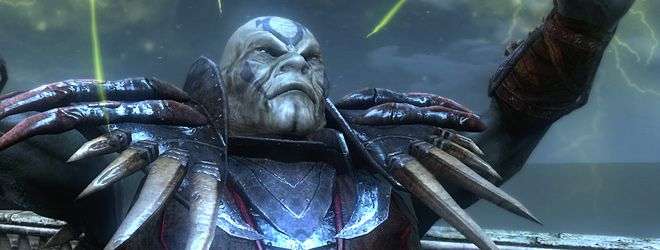










This is an excellent review. Glad to see that this game lived up to your expectations. Hopefully, it will follow on from its european success and find an audience in the UK and the US. The review also sounds a lot like it delivered all that the various Fable games promised us.
Bravo, Reality Pump
WANT!
I honestly thought this was going to be a lemon. Now I want it in my mouth.
I concurr with everything said here, I’m in the UK and imported the game, on my third SP playthrough whith a couple of hundred hours of play under my belt, haven’t even touched the magic system yet. Completely addicted to this one, haven’t been so blown away since Morrowind. And once the Gold Patch is released the game will be even better.
Now firmly on my radar for its launch. Thinking for a second it’s been a while since I’ve sat down with a good RPG looking forward to putting this through its paces.
I am now firmly off the fence, and very much on board for this! Hopefully I’ll get some cash for Christmas so I can pick up the Royal edition.
I was pretty disappointed by the original, mostly because of how apathetic I was left by the whole thing, but this looks great. I’m willing to give Two Worlds another shot, if only so I can waste days at a time with the new crafting system.
Good write up dood!
A fantastic review! And the game… wow… just… wow. It looks stunning!
I have to say that after playing it for 14hours (Lv 20) and haven’t yet finnish the first chapter this game is much more enjoyable than Oblivion!The side quest are a must too!This is my goty 2010!
loved the first game can’t wait till the 25th jan seems a long way off
Nicely written and detailed review MurkuzR.
I also played TW 1 and,personally, was left a little underwhelmed so it was with a feeling of trepidation that i ordered the German version of TW 2.The main reason for my buying this game was frankly because I had run out of RPG’s to play and couldn’t bring myself to start another run through of my old fallback RPG’s.
Inside the first 2 hours I must say I was sitting firmly in the “meh,it may kill a few hours of time” but once I started doing side quests I found myself utterly hooked by the game.
Like yourself I have barely even touched the wise wizard or the sneaky archer side of the game and focused exclusively on being a dual wielding psychopathic killing machine …..BUT this is no bad thing as it leaves me 2 whole aspects of the game for me to explore in my next 2 playthroughs of the game.Something which I found I couldn’t say about Oblivion as no matter how many times I played that game I always somehow found my character becoming a battlemage!
The game looks amazingly attractive and whilst this is all well and good it also lead me to suffer from a horrendous case of motion (simulator) sickness but still found myself coming back to play ,which surely must say something about the game imho).I’m just glad I play on the PC and did a search for a fix to my problem which took me to a friendly forum run by Zuxxez where I found a number of console commands which allowed me to tailor the gfx and effects to my requirements and now I no longer have to take a break every 30 to 60 minutes or risk having to run to throw up ….YES it gave me such bad motion sickness that I came very close to vomiting on more than one occasion!
All in all I have to say the game does more for me than Oblivion did and as people are already starting to make mods for TW2 and there’s talk of an upcoming “Gold Patch” I can only see Two Worlds 2 going from strength to strength and becoming a game against which other new games are judged in the future.On a side note I can also see Reality Pump making cash from their custom built game engine if they decide to license it to other games developers.
A fantastic review. It’s incredibly in-depth and it clearly shows how much time and effort you put into playing the game and come out with this.
Another sterling job dude, well done
Great stuff and a very in-depth look. From the positive responses to the game so far, it seems that the curse of the first game has been well and truly broken. From what I have seen being played, there was much to be impressed by, but still not enough that I think I’d actually get stuck into it…however, this is purely down to personal preference in things like management, inventory, how the lockpicking etc works as opposed to anything else. I tend to like playing as stealthy characters and the lockpicking looks excruciatingly tough, let alone the pick pocketing and backstabbing which seemed impossibly random at times. I think I’d have to abandon this approach!
The textures and environments look stunning and the sailing was beautiful. As the person who had the controller thrust at them initially, I have to concur with the steep learning curve remarks….getting away from the dock was a pain, but once in open water, it felt incredibly fluid and intuitive and was one of the things which had brought me close to putting my reservations aside and giving it a go in the future.
Great review of a very impressive looking game – let’s just hope that enough people can set aside the preconceptions based on the first title and champion this one…it sounds like it deserves it.
Solid review M.
Really enjoyed the first game despite its flaws. The premise was to be admired and the hope of a more fully realised version in the sequel did sound too good to be true.
Still, really learnt a lot from this review and I’m hoping I’ve been a good boy this year, would be awesome to find this on christmas day
I think it’s the idea of sailing that has me I played A LOT of Pirates of the Carribean a few years back. It was the single shittiest, buggiest game I’ve ever sunk my teeth into and it had next to nothing to do with the movies at all save for a fleeting reference here or there. It was just Bethesda’s Sea Dogs franchise re-painted and rushed out for the films but the sailing in it was so enjoyable. The idea of getting to play another game with something so benign as Sailing in really does tickle me (in a sexy way)
I played A LOT of Pirates of the Carribean a few years back. It was the single shittiest, buggiest game I’ve ever sunk my teeth into and it had next to nothing to do with the movies at all save for a fleeting reference here or there. It was just Bethesda’s Sea Dogs franchise re-painted and rushed out for the films but the sailing in it was so enjoyable. The idea of getting to play another game with something so benign as Sailing in really does tickle me (in a sexy way)
One of the best reviews I’ve read in ages… GREAT to read something proper for a change! MarkuzR, I’ve subscribed to your RSS feed, believe me that’s a rare occurrence.
What a wonderful and involving review! I have not played RPGs outside of MMOs for about half a decade, and I’m looking forward to the excuse to get myself reacquainted. Two Worlds II’s deep customization sounds like it would most certainly fit the bill and I am excited about the breadth of exploration that it promises, not just visually but through its gameplay mechanics as well! I’m glad that I dropped by to read this review, it offered great insight and gave me confidence into what I will be purchasing.
Most excellent review.
Thank you for the detailed readable and (most probably) objective review. It is not often than the reviewer writes his piece after more than one day with the game.
Btw., I agree about the original TW being undeservedly maligned in so many reviews. The game was released in the U.S. already after most (all?) bugs were fixed in Patch 1.5, and it run just fine. The world was huge and pretty, and the only bad thing was the pseudo-archaic English and quite bad voice acting. Other then that, I enjoyed the TW way more than, say, Dragon Age or some other “game of the year” mediocrities.
Even if the sequel were not improved, I would gladly spend $50 on it. The way things seem to be, it becomes a must-have for many. As a side-effect, it also will raise the bas for the ES5 Skyrim.
Megarelix – you are so right! How the heck Dragon Age did not get blasted for have NO exploration and just ENFORCED fast-travel to quest locations, with the odd asinine random battle thrown in occasionally, is beyond me! Same with calling games like Mass Effect and Alpha protocol “proper RPG’s”
After being patched up the original Two Worlds was a blast to play, and I think the dialogue was only a problem for U.S. players as in Europe we used to that. And in any vent it had humour as part of it and a charm because of it!
I have 20 hours in Two Worlds II, after 80+ in the original, and am having another blast! I am surprised no one has mentioned the fantastic horse riding, which is a simulation in itself and where you have to put skill points into the riding so you don’t fall off and can turn easier! After riding in two Worlds, I cannot stand the inane horse riding in Oblivion!
So an excellent, educated review. So much better than what we get from the big gaming sites!
UK_John, I guess Dragon Age didn’t get “blasted” because it was a brilliant game otherwise… but I agree it did have it’s flaws. I don’t think it’s going to age very well.
Those Oblivion horses… shudder…
Louis. So you think if Two worlds or Two Worlds II or any cRPG that came before or even after Dragon Age however good otherwise, would be able to have no exploration and enforced fast travel without getting blasted? I think not!
As to DA reviews, the no exploration and fast ravel only was never even mentioned in the major gaming sites reviews, and to me, that is even scarier than blasting it! Why is it that the first RPG in 20 years or so to have enforced fast travel instead of exploration, like Oblivion, Morrowind, The Ultima series, the Wizardry series, the Gothic series, Daggerfall, Arena, the Gold Box RPG’s and back to the beginning of gaming, never had a single review that mentioned it at all? This just tells me, that if you are one of the major players in the market you get special treatment – and that should be scary to all gamers, whether they loved DA or not!
SO refreshing to hear a compelling argument, exactly what I love about this site. And good to meet another Wizardry & Ultima fan
I agree that exploration is a crucial element of your classic RPG, but I think DA was more focused on telling an engaging story. They pulled that off very well methinks.
I’d love to hear somebody else’s thoughts on this.
Louis, if you concentrate on characters and story and don’t have exploration, but you still have combat, isn’t that an Action-Adventure rather than cRPG? Certainly it has the character stats that makes it an RPG. But like putting water in your whiskey, at some point, if you keep taking away the whiskey, you have water. Sure there’s still whiskey ion their somewhere, but taste wise, it’s now water.
Such it is with Jade Empire, Mass Effect and Dragon Age, so little roleplaying ans so much story/action, at what point does a game become an action adventure? Are the latest Bioware games closer to Tomb Raider than Wizardry, and if these titles are accepted by the market as “RPG’s”, what does this mean for the future of real RPG’s?
I remember having very similar conversations a decade ago as the media insisted the first Tomb Raider was an “Action-Adventure”, and adventure fans (Grim Fandago, The Longest Journey, etc) insisted loudly that that game had no “adventuring” in it. With the media batting for the industry, rather than gamers, as it usually does, it was to no avail. And now we get no adventure games from the major publishers.
I’ll end on a high note. As large U.S. companies move away from PC to console style games, so European developers are stepping up. Two Worlds II shows this. Europe is also producing intelligent, innovative shooters like STALKER and Metro 2033, it produces adventure games like Syberia and Still Life, it produces quirky 90′s style games with Space Rangers 2, a 2D game with 3D Mechwarrior style land battles, Star Control II type trading and ship upgrading with shields, engines, weapons, etc, Asteroid arcade style game when entering black holes and a dynamic world with dynamic trading and procedural missions! Europe is bringing games to market for 1/3 of what the large U.S. companies are spending, and over the long term, games like Two Worlds II will be seen as a better RPG than Dragon Age, that, with Dragon Age 2, seems to be moving to a Mass Effect style Action-Adventure.
[...] and saving their cash towards Dragon Age 2. Thankfully we imported our copy from Germany – clicky for review – but we’ve been eyeing the release woes with increasing [...]